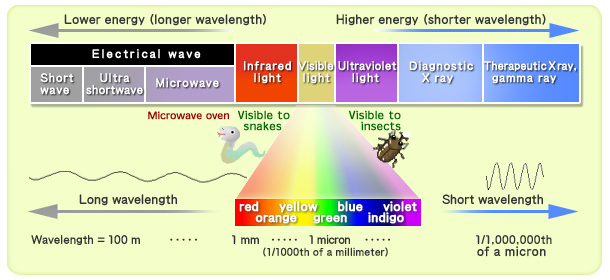It seems like every new product I see claims to protect against blue light. I decided to investigate, to determine how much of a threat blue light truly is, and whether we should all be using blue light glasses and covering ourselves in blue light protection.
Science of sun’s emissions
We’re all used to the idea that the sun radiates sunlight, and if you shine sunlight through a prism, you can get a rainbow of colours. Each colour corresponds to a specific wavelength or vibration of the sun’s energy. The sun emits a broad range of wavelengths that goes far beyond the wavelengths of visible light.

Energy emitted by sun, ranging from infrared on left, visible light in the middle, and ultraviolet and beyond on the right.
The rainbow of visible light is only the narrow yellow segment in the diagram. Longer wavelengths include infrared, microwaves and radio waves. Shorter wavelengths include ultraviolet, x-rays and gamma waves.
The shorter wavelengths are higher energy, and hence more damaging. It is estimated that 75% of the damage caused by the sun’s emissions is due to ultraviolet wavelengths, even though ultraviolet only makes up about 7% of the total output from the sun. Therefore, it makes sense that sunscreen, a product developed to protect our skin from UV light, is the most important protection that we should be using every day.
You can see that blue light is towards the right end of the rainbow in the diagram, meaning that blue, indigo and violet light are higher energy than green, yellow, orange and red so blue, indigo and violet are more damaging than the other colours.
Damage from any wavelength
It turns out that any wavelength of light can be damaging. The issue is the amount of exposure, which we should think of in terms of intensity (brightness), duration of exposure and proximity to the source. The further you are from the source, the less damaging it is.
For example, infrared isn’t a big cause of harm for most people nowadays. However, back in the days when people huddled around the fireplace to keep warm, they commonly suffered from skin conditions caused by the infrared light emitted by the fire. These skin conditions included red rashes, brown pigmentation in a network pattern, dilated blood vessels, precancerous spots similar to what we associate with UV damage and accelerated aging of the skin. A fire as a source of infrared generally has greater intensity than the sun, definitely is much closer and in cold climates, the exposure would be many days of the year for years.

What is it about our exposure to blue light that has brought it into the limelight (forgive the pun) today?
It turns out that the light from LEDs includes a large component of blue light, and we’re surrounded by LED lights, including in our TVs, tablets, monitors and phones. With a lot of these being personal devices, the likelihood of them being pretty close to our faces is high, and how many of us are glued to our devices? So the exposure occurs over hours and hours every day. And if you use the flash on your phone to take selfies, you’re getting a little boost in the intensity of the blue light.
What are the harms of blue light?
- In experimental models, blue light resulted in damage to the retina (light receptors at the back of the eye) and decreased vision
- Blue light exposure outside of daylight hours alters circadian rhythms, leading to difficulty sleeping at night and being alert during the day
- Blue light impairs the barrier function of the skin, allowing pollution to penetrate the skin more easily and cause harm
- Blue light can induce oxidative damage (same as UV light) leading to damage to DNA, which could lead to skin cancer, and damage to proteins like collagen which lead to wrinkles and aged appearance of the skin
- Blue light can cause darkening of pigmentation of the skin, usually in an uneven distribution, i.e. brown spots rather than an even tan. This effect is more pronounced in brown skin than lighter skin tones.
How can you protect yourself from blue light?
- Reduce exposure as much as possible, including reducing proximity to the source (keep screens at a distance), avoiding intensity (LED flash) and reducing the duration of exposure, if possible
- Sunscreens are ineffective against blue light. Antioxidants are effective at reducing damage from blue light.
- Mineral makeup can block blue light from reaching the skin
- Blue light glasses can help protect the eyes from damage
KEY POINTS
75% of damage from the sun’s rays is caused by ultraviolet light
Ultraviolet light constitutes about 7% of the sun’s emissions
Any light (UV, visible light or infrared) can cause damage if the intensity, proximity to source or duration of exposure is high enough
Damage from light can enable pollution to cause more harm
Sunscreens are not effective at blocking visible light or infrared
Antioxidants protect against visible light, including blue light, and infrared
Mineral makeup has a barrier effect, protecting against blue light